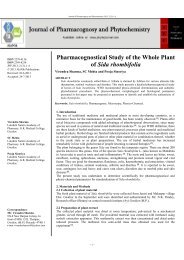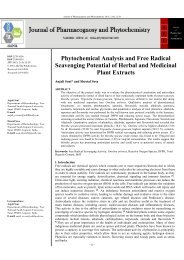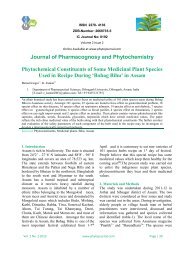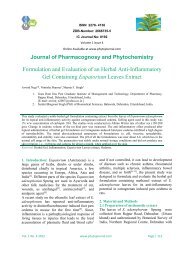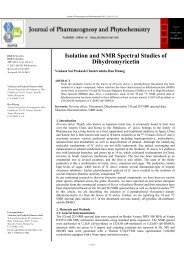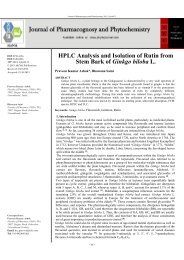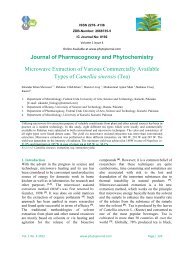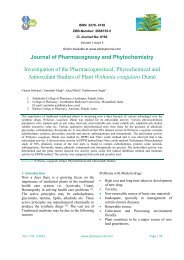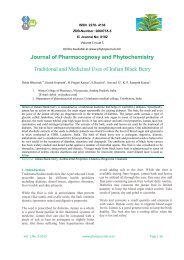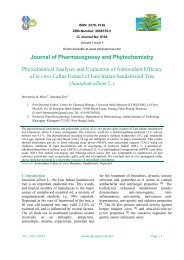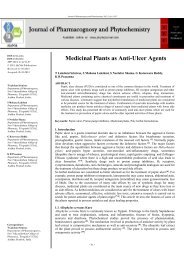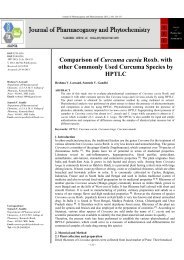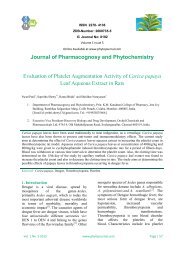Phytochemical Investigation, Isolation and Characterization of ...
Phytochemical Investigation, Isolation and Characterization of ...
Phytochemical Investigation, Isolation and Characterization of ...
Create successful ePaper yourself
Turn your PDF publications into a flip-book with our unique Google optimized e-Paper software.
ISSN 2278- 4136<br />
ZDB-Number: 2668735-5<br />
IC Journal No: 8192<br />
Volume 2 Issue 1<br />
Online Available at www.phytojournal.com<br />
Journal <strong>of</strong> Pharmacognosy <strong>and</strong> Phytochemistry<br />
<strong>Phytochemical</strong> <strong>Investigation</strong>, <strong>Isolation</strong> <strong>and</strong> <strong>Characterization</strong><br />
<strong>of</strong> Betulin from Bark <strong>of</strong> Betula Utilis<br />
Himanshu Joshi 1* , Gyanendra Kumar Saxena 2 , Vikas Singh 2 , Ekta Arya 2 , Rahul Pratap Singh 2<br />
1. Department <strong>of</strong> Pharmaceutical sciences, Kumaun University, Nainital, India<br />
[E-mail: hijoshi1234@gmail.com]<br />
2. Faculty <strong>of</strong> Pharmacy, Naraina group <strong>of</strong> institutions, Panki, Kanpur, India<br />
Betula utilis is a hardy perennial plant <strong>of</strong> moderate size up to 20 M in height, forming the upper limit <strong>of</strong> forest<br />
vegetation. It inhabitates along the Himalayan range from Bhutan westwards, ascending to an altitude <strong>of</strong> 4200 M.<br />
The bark <strong>of</strong> Betula utilis contains sitosterol, betulin, betulic acid, oleanolic acid, acetyloleanolic acid, lupeol,<br />
lupenone, methyl betulonate, methyl betulate <strong>and</strong> a new triterpenoid karachic acid. The ethanolic extract <strong>of</strong><br />
powdered drug <strong>of</strong> Betula utilis was prepared. Most <strong>of</strong> the constituents were found to be present in the ethanolic<br />
extract. Thus it was concluded that constituents <strong>of</strong> Betula utilis bark are more soluble in polar solvents. The<br />
ethanolic extract showed the presence <strong>of</strong> alkaloids, carbohydrates, flavonoids, saponins <strong>and</strong> triterpenes. After<br />
identification <strong>of</strong> crude extract, the main work was to isolate the desired compound (betulin). So, fractionation <strong>of</strong><br />
ethanolic extract was done by suspending it in water <strong>and</strong> then extracted it with n-hexane <strong>and</strong> dichloromethane.<br />
Betulin was isolated from dichloromethane fraction using column chromatography. Ethyl acetate <strong>and</strong> n-hexane in<br />
various ratios (1:10; 1:5; 1:3; 1:2) was used as eluent for separation <strong>of</strong> desired compound from the dichloromethane<br />
fraction. After isolation <strong>of</strong> desired compound, it was subjected to characterization. For characterization studies;<br />
melting range, TLC <strong>and</strong> spectroscopic techniques (UV, IR, Mass <strong>and</strong> NMR) were utilized.<br />
Keyword: Altitude, Betulin, Ethanolic extract, Column chromatography, TLC, <strong>Isolation</strong><br />
1. Introduction<br />
Betula utilis is a hardy perennial plant <strong>of</strong><br />
moderate size up to 20 M in height, forming the<br />
upper limit <strong>of</strong> forest vegetation. It inhabitates<br />
along the Himalayan ranges from Bhutan<br />
westwards, ascending to an altitude <strong>of</strong> 4200 M.<br />
Scientific Classification<br />
The bark <strong>of</strong> Betula utilis contains sitosterol,<br />
betulin, betulic acid, oleanolic acid,<br />
acetyloleanolic acid, lupeol, lupenone, methyl<br />
betulonate, methyl betulate <strong>and</strong> a new<br />
triterpenoid karachic acid [1,2] . Leucocyanidin <strong>and</strong><br />
polymeric leucoanthocyanidins are also present in<br />
this plant.<br />
Kingdom<br />
Phylum<br />
Class<br />
Order<br />
Family<br />
Genus<br />
Species<br />
: Plantae<br />
: Tracheophyta<br />
: Magnoliopsida<br />
: Corylales<br />
: Betulaceae<br />
: Betula<br />
: utilis<br />
Vol. 2 No. 1 2013 www.phytojournal.com Page | 145
Journal <strong>of</strong> Pharmacognosy <strong>and</strong> Phytochemistry<br />
1.2 Description:<br />
In its native habitat, B. utilis tends to form forests,<br />
growing as a shrub or tree reaching up to 20 m<br />
(66 ft) tall. It frequently grows among scattered<br />
conifers, with an undergrowth <strong>of</strong> shrubs that<br />
typically includes evergreen Rhododendron. The<br />
tree depends on moisture from snowmelt, rather<br />
than from the monsoon rains. They <strong>of</strong>ten have<br />
very bent growth due to the pressure <strong>of</strong> the deep<br />
winter snow in the Himalaya. Leaves are ovate, 5<br />
to 10 cm (2.0 to 3.9 in) long, with serrated<br />
margins, <strong>and</strong> slightly hairy. Flowering occurs<br />
from May–July, with only a few male catkins,<br />
<strong>and</strong> short, single (sometimes paired) female<br />
catkins. The perianth has four parts in male<br />
flowers, <strong>and</strong> is absent in the female flowers [3] .<br />
Fruits ripen in September–October. The thin,<br />
papery bark is very shiny, reddish brown, reddish<br />
white, or white, with horizontal lenticels. The<br />
bark peels <strong>of</strong>f in broad, horizontal belts, making it<br />
very usable for creating even large pages for<br />
texts. A fungal growth, locally called bhurjagranthi,<br />
forms black lumps on the tree weighing<br />
up to 1 kg. The wood is very hard <strong>and</strong> heavy, <strong>and</strong><br />
quite brittle. The heartwood is pink or light<br />
reddish brown [4] .<br />
Image-1<br />
Image-2<br />
1.3 Conservation:<br />
Deforestation due to overuse <strong>of</strong> the tree has<br />
caused loss <strong>of</strong> habitat for many native groves <strong>of</strong><br />
B. utilis (locally called bhojpatra in the Indian<br />
Himalaya). The first high-altitude bhojpatra<br />
nursery was established in 1993 at Chirbasa, just<br />
above Gangotri, where many Hindus go on<br />
pilgrimage to the source <strong>of</strong> the sacred Ganges<br />
river. Dr. Harshvanti Bisht, a Himalayan<br />
mountaineer, established the first nursery <strong>and</strong><br />
continues to exp<strong>and</strong> the reforestation <strong>of</strong> bhojpatra<br />
in the Gangotri area <strong>and</strong> inside Gangotri National<br />
Park [5] . About 12,500 bhojpatra saplings had been<br />
planted in the area by the year 2000. In recent<br />
years, attempts have been made to ban the<br />
collection <strong>of</strong> bhojpatra trees in the Gangotri<br />
area [6] .<br />
1.4 Varieties <strong>and</strong> Cultivars:<br />
Many named varieties <strong>and</strong> cultivars are used in<br />
l<strong>and</strong>scaping throughout the world. In the eastern<br />
end <strong>of</strong> the tree's native distribution, several forms<br />
have orange- or copper-colored bark. Betula utilis<br />
var. jacquemontii, from the western end <strong>of</strong> the<br />
native habitat, is widely used because several<br />
cultivars have especially white bark. These<br />
include:<br />
'Doorenbos'<br />
'Grayswood Ghost'<br />
'Jermyns'<br />
'Silver Shadow'<br />
'Snow Queen'<br />
B. utilis 'Fascination' has an orange- to<br />
mahogany-colored bark, which peels <strong>of</strong>f to reveal<br />
a polished-looking layer underneath. The bark <strong>of</strong><br />
'Wakehurst Place Chocolate', as the name<br />
implies, is dark brown to nearly black [7] .<br />
2. Material <strong>and</strong> Methods:<br />
2.1 <strong>Phytochemical</strong> <strong>Investigation</strong>:<br />
‣ Collection <strong>of</strong> plant material: - The bark <strong>of</strong><br />
Betula utilis (Bhojpatra) was collected in<br />
the month <strong>of</strong> December from Munsiary<br />
village (near Sarmoli village) <strong>of</strong><br />
Pithoragarh district <strong>of</strong> Uttarakh<strong>and</strong> state.<br />
‣ Identification <strong>and</strong> authentication <strong>of</strong> plant:-<br />
The bark <strong>of</strong> Betula utilis (Bhojpatra) was<br />
identified <strong>and</strong> authenticated from<br />
National Botanical Research Institute,<br />
Lucknow under the Ref. No.:<br />
NBRI/CIF/132/2009 dated 11-01-2010.<br />
‣ Drying <strong>of</strong> plant material: The bark <strong>of</strong><br />
Betula utilis (Bhojpatra) was dried in<br />
shade.<br />
‣ Coarse powder <strong>of</strong> the plant: The dried<br />
bark <strong>of</strong> Betula utilis (Bhojpatra) was cut<br />
into small pieces <strong>and</strong> then powdered with<br />
the help <strong>of</strong> mixer grinder.<br />
Vol. 2 No. 1 2013 www.phytojournal.com Page | 146
Journal <strong>of</strong> Pharmacognosy <strong>and</strong> Phytochemistry<br />
2.2 Preparation <strong>of</strong> Crude Extract<br />
The powdered bark <strong>of</strong> Betula utilis (45 gm) was<br />
defatted with petroleum ether (1.25 L) <strong>and</strong> then<br />
the defatted powder <strong>of</strong> bark <strong>of</strong> Betula utilis was<br />
extracted with 95% ethanol (1.25 L) in the<br />
soxhlet apparatus at 40ºc for about 72 hours.<br />
After the completion <strong>of</strong> extraction, the extract<br />
was concentrated at vacuum rotary evaporator to<br />
get a yellowish brown residue which was placed<br />
in vacuum desiccator for 4-5 days for drying <strong>and</strong><br />
then used for subsequent experiments. The<br />
process is repeated with rest <strong>of</strong> drug again [8,9] .<br />
Table 1: Extractive value <strong>of</strong> different extracts <strong>of</strong> Betula<br />
utilis<br />
Plant<br />
name<br />
Betula<br />
utilis<br />
Parts<br />
used<br />
Bark<br />
Method <strong>of</strong><br />
Extraction<br />
Continuous<br />
Hot<br />
Percolation<br />
(Soxhlet<br />
Extraction)<br />
% Yield <strong>of</strong><br />
Petroleum<br />
ether<br />
extract<br />
% Yield<br />
<strong>of</strong><br />
95%<br />
Ethanolic<br />
extract<br />
6.88% 20.75%<br />
2.3 <strong>Isolation</strong> <strong>of</strong> Compound:<br />
2.3.1 Fractionation <strong>of</strong> Ethanol Extract:<br />
15 gm <strong>of</strong> ethanolic extract was suspended in<br />
water (300 ml) <strong>and</strong> then extracted with n-hexane<br />
(300 ml × 3) <strong>and</strong> dichloromethane (300 ml × 3)<br />
using the principle <strong>of</strong> liquid/liquid extraction.<br />
Then both the fractions are concentrated in<br />
vacuum rotary evaporator <strong>and</strong> concentrated<br />
fractions are put for drying in desiccators for 4 - 5<br />
days. Then both the fractions were characterized<br />
by TLC, <strong>and</strong> found that the R f <strong>of</strong> the aimed<br />
compound (Betulin) match with the TLC <strong>of</strong><br />
dichloromethane fraction. So, the<br />
dichloromethane fraction was used for further<br />
isolation by column chromatography.<br />
Percentage yield <strong>of</strong> n-hexane fraction: The % yield <strong>of</strong> n-<br />
hexane fraction was found to be 22% w/w.<br />
Percentage yield <strong>of</strong> dichloromethane fraction: The %<br />
yield <strong>of</strong> dichloromethane fraction was found to be 70.20%<br />
w/w.<br />
2.3.2 <strong>Isolation</strong> <strong>of</strong> Active Component from<br />
Dichloromethane Fraction<br />
The column (3.5 × 60 cm) was prepared with<br />
silica gel (60-120 mesh) in n-hexane by wet<br />
method <strong>and</strong> column is put for overnight. Then the<br />
dichloromethane fraction (8 gm) was poured to<br />
silica gel open column chromatography <strong>and</strong> step<br />
gradient technique was used to run the column.<br />
Various ratios <strong>of</strong> ethyl acetate <strong>and</strong> n-hexane<br />
(1:10, 500 ml; 1:5, 500 ml; 1:3, 500 ml; 1:2, 350<br />
ml) were used for the isolation <strong>of</strong> active<br />
component. The fractions <strong>of</strong> 50 ml were<br />
collected; characterized by TLC <strong>and</strong> same type <strong>of</strong><br />
fractions are mixed; then again characterized by<br />
TLC <strong>and</strong> found that the aimed compound<br />
(betulin) is present as a single spot in the fraction<br />
collected from the 1:2 (ethyl acetate <strong>and</strong> n-<br />
hexane) solvent system <strong>and</strong> the R f value for this<br />
fraction was found to be 0.4705 which is similar<br />
to the R f value <strong>of</strong> betulin in this solvent system.<br />
2.4 <strong>Characterization</strong> <strong>of</strong> Isolated Compound:<br />
Physical Properties<br />
Colour: yellowish white<br />
State: solid<br />
Solubility: soluble in chlor<strong>of</strong>orm <strong>and</strong> ethyl<br />
acetate<br />
Melting Point: 242-246 °C (determined by open<br />
capillary method)<br />
R f Value: 0.4705 in ethyl acetate <strong>and</strong> n-hexane<br />
(1:2)<br />
3. Result <strong>and</strong> Discussion<br />
After identification <strong>of</strong> crude extract, the main<br />
work was to isolate the desired compound<br />
(betulin). So, fractionation <strong>of</strong> ethanolic extract<br />
was done by suspending it in water <strong>and</strong> then<br />
extracted it with n-hexane <strong>and</strong> dichloromethane.<br />
Betulin was isolated from dichloromethane<br />
fraction using column chromatography. Ethyl<br />
acetate <strong>and</strong> n-hexane in various ratios (1:10; 1:5;<br />
1:3; 1:2) was used as eluent for separation <strong>of</strong><br />
desired compound from the dichloromethane<br />
fraction. After isolation <strong>of</strong> desired compound, it<br />
was subjected to characterization. For<br />
characterization studies; melting range, TLC <strong>and</strong><br />
spectroscopic techniques (UV, IR, Mass <strong>and</strong><br />
NMR) were utilized.<br />
Vol. 2 No. 1 2013 www.phytojournal.com Page | 147
Journal <strong>of</strong> Pharmacognosy <strong>and</strong> Phytochemistry<br />
Fig. 1: TLC <strong>of</strong> isolated compound [Betulin] in iodine<br />
chamber<br />
Fig. 2: TLC <strong>of</strong> ethanolic extract in iodine chamber<br />
S. No.<br />
1.<br />
2.<br />
3.<br />
4.<br />
5.<br />
6.<br />
Table 2: Partition coefficient data for isolated compound betulin:<br />
Concentration <strong>of</strong> solution<br />
containing isolated compound<br />
(Betulin)<br />
Absorbance at 318 nm wavelength (λ<br />
max<br />
)<br />
5 µg/ml solution in Concentrated<br />
H<br />
2<br />
SO<br />
4<br />
0.087<br />
10 µg/ml solution in Concentrated<br />
H<br />
2<br />
SO<br />
4<br />
0.242<br />
15 µg/ml solution in Concentrated<br />
H<br />
2<br />
SO<br />
4<br />
0.324<br />
20 µg/ml solution in Concentrated<br />
H<br />
2<br />
SO<br />
4<br />
0.402<br />
25 µg/ml solution in Concentrated<br />
H<br />
2<br />
SO<br />
4<br />
0.540<br />
30 µg/ml solution in Concentrated<br />
H<br />
2<br />
SO<br />
4<br />
0.631<br />
7.<br />
Octanol phase (Unknown<br />
concentration)<br />
8.<br />
Water Phase (Unknown<br />
concentration)<br />
So, partition coefficient (P) <strong>of</strong> isolated compound (Betulin) = 2.35.<br />
0.270<br />
0.110<br />
Fig. 3: Graph shows partition coefficient <strong>of</strong> data in water phase, octanol phase <strong>and</strong> in concentrate H 2 SO 4<br />
Vol. 2 No. 1 2013 www.phytojournal.com Page | 148
Journal <strong>of</strong> Pharmacognosy <strong>and</strong> Phytochemistry<br />
2.5 Spectral Techniques:<br />
UV Spectroscopy:<br />
Fig. 4: UV spectra <strong>of</strong> isolated compound Betulin<br />
IR Spectroscopy:<br />
Fig. 5 IR characterization <strong>of</strong> isolated compound Betulin<br />
Mass Spectroscopy:<br />
Fig. 6 Mass spectra <strong>of</strong> isolated compound Betulin<br />
Vol. 2 No. 1 2013 www.phytojournal.com Page | 149
Journal <strong>of</strong> Pharmacognosy <strong>and</strong> Phytochemistry<br />
NMR Spectroscopy:<br />
Fig. 7: 1 H-NMR Spectra <strong>of</strong> isolated compound Betulin<br />
Melting range <strong>of</strong> the isolated compound,<br />
determined by open capillary method, was found<br />
to be 242-246°C, which is uncorrected <strong>and</strong><br />
comparable with that <strong>of</strong> st<strong>and</strong>ard betulin which is<br />
248-251°C.<br />
Partition coefficient <strong>of</strong> isolated compound was<br />
found to be 2.35 in octanol <strong>and</strong> water.<br />
Wavelength <strong>of</strong> maximum absorbance (λ max ) <strong>of</strong><br />
isolated compound was found to be 318 nm in<br />
concentrated sulphuric acid which is very close to<br />
316 nm which is <strong>of</strong> st<strong>and</strong>ard betulin in<br />
concentrated sulphuric acid.<br />
‣ FT-IR spectrum <strong>of</strong> isolated compound gave<br />
characteristic peaks <strong>of</strong> groups present in the<br />
isolated compound like C-H (alkane), -CH 3<br />
(bending), C=C, C-O <strong>and</strong> -OH group.<br />
‣ Mass spectroscopy <strong>of</strong> isolated compound was<br />
performed, by DART technique, showing a<br />
molecular ion peak at M + +1 i.e. at 443.43,<br />
while calculated molecular weight <strong>of</strong> betulin<br />
(molecular formula-C 30 H 50 O 2 ) is 442.<br />
‣ Proton NMR spectroscopy was used for the<br />
confirmation <strong>of</strong> structure <strong>of</strong> isolated<br />
compound; in which various peaks in CDCl 3<br />
were found at δ value 1.0-1.1 (t, 7H); 1.11-1.3<br />
(m, 5H); 1.4 (d, 7H); 1.5-1.7 (m, 17H); 1.8-<br />
2.1 (m, 5H); 2.14-2.3 (m, 1H); 2.31-2.46 (m,<br />
1H); 3.0 (d, 1H); 3.2 (q, 1H); 3.34 (d, 1H);<br />
3.8 (d, 1H); 4.6 (d, 1H); 4.68 (s, 1H); 4.75 (s,<br />
1H) <strong>and</strong> it shows the presence <strong>of</strong> 50<br />
hydrogens in the compound.<br />
On the basis <strong>of</strong> characterization studies <strong>of</strong><br />
isolated compound, it was concluded that the<br />
isolated compound may be betulin <strong>and</strong> its<br />
structure is determined as follows.<br />
4. Conclusion<br />
On the basis <strong>of</strong> characterization studies, the<br />
isolated compound has physical properties<br />
(colour, state, solubility, melting range <strong>and</strong> R f<br />
value) which are identically resemble with the<br />
st<strong>and</strong>ard betulin. Spectral data shows that the<br />
isolated compound has λ max which is mostly<br />
similar to st<strong>and</strong>ard betulin; IR peaks <strong>of</strong> various<br />
functional groups <strong>of</strong> betulin are found in this<br />
isolated compound; M + +1 peak was also obtained<br />
in the mass spectra <strong>of</strong> the isolated compound <strong>and</strong><br />
above all, 50 protons are found in the 1 H-NMR<br />
spectra <strong>of</strong> isolated compound. So, it can be<br />
concluded that the isolated compound is similar<br />
to the molecular formula C 30 H 50 O 2 , which<br />
corresponds to the molecular formula <strong>of</strong> betulin.<br />
So, the isolated compound was found to be<br />
betulin.<br />
5. Acknowledgement<br />
The author has highly thankful to Department <strong>of</strong><br />
Pharmaceutical Sciences, Kumaun University,<br />
Vol. 2 No. 1 2013 www.phytojournal.com Page | 150
Journal <strong>of</strong> Pharmacognosy <strong>and</strong> Phytochemistry<br />
Nainital for conduct this research work <strong>and</strong> also<br />
help to other kind <strong>of</strong> difficulties. Author also<br />
thanks to NBRI, Lucknow for their plant<br />
authentication <strong>and</strong> CDRI, Lucknow for their 1 H-<br />
NMR <strong>and</strong> Mass Spectrometry.<br />
6. References<br />
1. Anonymous. Betula. The Wealth <strong>of</strong> India: Raw<br />
Material; 1st ed.; Publication Information<br />
Directorate, CSIR, New Delhi, 1988; Vol. 2, 148.<br />
2. http.//species.wikimedia.org/wiki/Betula<br />
utilis, accessed October 2009.<br />
3. Rastogi, R. P.; Mehrotra, B. N. Indian Medicinal<br />
Plants. Compendium <strong>of</strong> Indian Medicinal Plants;<br />
1st ed.; NISCAIR Press, National Institute <strong>of</strong><br />
Science Communication <strong>and</strong> Information<br />
Resources, CSIR, New Delhi, 2004; pp 57.<br />
4. http://www.epilepsyindia.org/home.asp,<br />
accessed October 2010.<br />
5. Hardman, J.G.; Limbird, L.E. Pharmacotherapy<br />
<strong>of</strong> the Epilepsies. Goodman & Gilman's the<br />
Pharmacological Basis <strong>of</strong> Therapeutics; 11th<br />
ed.; McGraw hill: New York, 2006; 518-521.<br />
6. Khan, M. A,; Rahman, A. U. Karachic Acid: A New<br />
Triterpenoid from Betula utilis. Phytochem.<br />
1975, 14, 789-791.<br />
7. Meurer, B.; Wiermann, R.; Strack, D.<br />
Phenylpropanoid Patterns in Fagales Pollen <strong>and</strong><br />
Their Phylogenetic Relevance. Phytochem.<br />
1988, 27, 823-828.<br />
8. Kolodziej, H. Thiolysis <strong>of</strong> Birch Bark<br />
Procyanidins. Phytochem. 1990, 29, 1671-1674.<br />
9. Shuang, T.; Wang, J. X.; Zheng, X. J. Simple<br />
Synthesis <strong>of</strong> Allobetulin, 28-oxyallobetulin from<br />
Betulin <strong>and</strong> Betulinic Acid. J. Chem. Soc. 1998, 1,<br />
3957-3965.<br />
Vol. 2 No. 1 2013 www.phytojournal.com Page | 151



